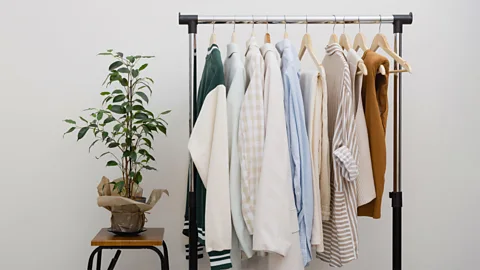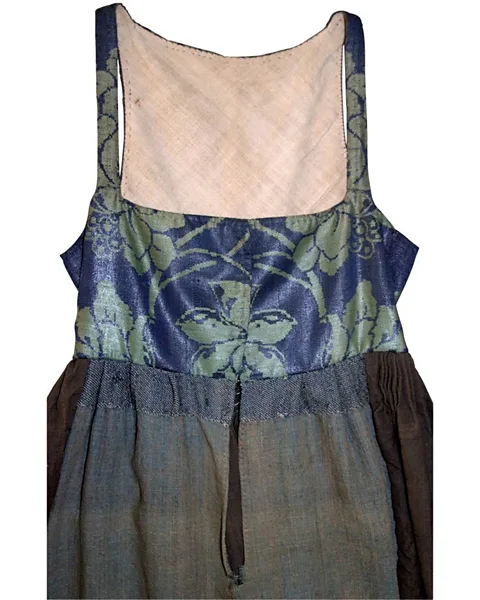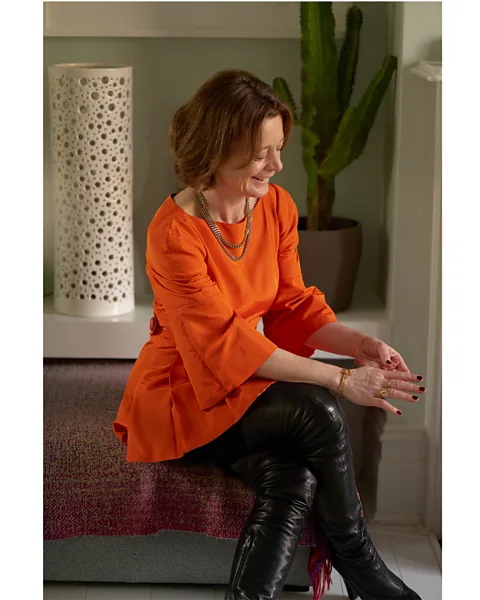The rise of the minimalist wardrobe |
您所在的位置:网站首页 › MinimalistEnglish › The rise of the minimalist wardrobe |
The rise of the minimalist wardrobe
The rise of the minimalist wardrobe1 April 2023By Matilda Welin, Features correspondent  Alamy(Credit: Alamy) Alamy(Credit: Alamy)According to fans of capsule dressing, it's all about less is more, and the "rule of five". So is it time to return to more old-fashioned ways of thinking about what we wear, asks Matilda Welin. "Since Christmas, I've been to four weddings", writes a user of online forum Mumsnet. "I wore the same outfit to three... My cousin [said] I was disrespectful, that... it was rude and that if I didn't want to go I should have declined the invitation rather than turn up inappropriately dressed. [Have I] made a massive faux pas?" "[I joined a] challenge, where people wear the [same] dress 100 days in a row," says another chat site user, this time on work advice site Ask a Manager. "I was called into my boss's office and he... said he had to talk to me about how I presented myself at work... Can I really get in trouble for continuing to wear my dress every day?" More like this: - How to make your clothes last longer - The most ingenious recycled homes - Inside the ethical beauty boom In the Western world, there is an unspoken rule. Don't wear the same clothes too often. Even though the wedding guest and the office worker above were both reassured by others that they had done nothing wrong, the feeling remains. Every day – or at least every few days – we are expected to change what we are wearing. Even if we work in an office and not in a sweaty factory or in a sun-baked field. Even though washing machines exist. And we must constantly update our wardrobes. Even green initiatives like clothes-swap events and wardrobe libraries, aimed at helping us be sustainable, push the same idea: what we already have is not enough.   AlamyIt's an unspoken rule in the Western world that we should vary our outfits frequently – but the eco-conscious are increasingly questioning that notion (Credit: Alamy) AlamyIt's an unspoken rule in the Western world that we should vary our outfits frequently – but the eco-conscious are increasingly questioning that notion (Credit: Alamy)The overabundance of cheap clothes means that many of us use only 20% of the garments in our wardrobes. Meanwhile, the clothing industry wreaks havoc on our fellow humans and on the planet. But it didn't use to be like this. Today's hyper-paced shopping and discarding is a relatively new phenomenon. And as the fashion business battles increasing sustainability problems, we may soon have to revert back to the norm. One way of tackling overconsumption is by reducing what you wear. Outside of uniformed jobs, being exempt from the need to vary your look is a luxury mainly afforded to men, and the habit of wearing an identical outfit every day is embraced almost solely by men, be that Mark Zuckerberg, Steve Jobs or almost every suit-wearing office worker in the world. Jennifer Logan lives with her husband and two children in California, where she works as an osteopath. Around 10 years ago, after she and a friend started talking about how great it would be to have a uniform in order not to have to think about what to wear, she made a wool dress out of second-hand jumpers and wore it almost every day – until it shrunk in the wash. Back to wearing clothes in a more usual way, Logan battled with decision fatigue. Finally, she bought a new dress: black, knee-length, sleeveless. Three years later, it's still practically the only garment she uses. "I wear it for everything," Logan tells BBC Culture. "Date night... Everything I ever do. I am wearing it to a work conference this week." She only dons alternative wear, like her pyjamas or sweatshirt and sweatpants borrowed from her daughter, for messy cleaning or for ceramics class. Logan has built her wardrobe around her dress. She sometimes adds merino leggings or, if it's cold, trousers or a sleeved top. Before, she would spend most days in jeans and a T-shirt, but now, she says, she always feels dressed up. And no-one seems to notice it's the same dress. Quality not quantity Tackling overconsumption by just reducing what you wear is not without complications. Fashion has a function, and what we chose to wear any given day tells the world who we are. And even though Logan dresses her garment up or down by adding accessories, she also says she has recently begun feeling a little tired of wearing black every day and is now considering swapping her black dress for one of colour.   Marie UlvängGarments were once so expensive that they were remade several times – a bodice in the 1700s could become a dress in the 1820s (Credit: Marie Ulväng) Marie UlvängGarments were once so expensive that they were remade several times – a bodice in the 1700s could become a dress in the 1820s (Credit: Marie Ulväng)There is also the issue of quality. Logan explains that her practice can be adopted on any budget, with wearers using second-hand clothes or going down to a capsule wardrobe of a few outfits in order not to wear garments out. But the fact remains that a lot of modern clothes aren't made to be worn every day. They are far from durable, long-lasting investments. In many cases, we have to buy new. In the 17th and 18th Centuries, clothes were among the most expensive things families would own"In the 17th and 18th Centuries, clothes were among the most expensive things families would own," Professor Beverly Lemire from the University of Alberta tells BBC Culture. Such was the value of fabric, that in 18th-Century London, a quarter of thefts brought to court involved textiles and clothing. "[Clothes] could have lives that lasted decades," Lemire says. "They were worn until they were rags." However, this didn't stop people from changing their looks. Instead, variation and individuality were to be found in the detail. Individual fit, adherence to slowly changing fashion trends or even personal touches were achieved via altering. "Clothes were made to be unmade," Lemire explains. It was expected that garments would be taken apart, taken in, taken out and amended. All seams were hand-stitched. All clothes had repairs. Ribbons and buttons were used to liven up old garments, and records tell of young men identifying with a certain group by having long curls in their hair or wearing hosiery with a certain kind of stripe. However, things were already speeding up. In the 17th and 18th Centuries, people wore a lot of undyed fabric at home, like linen and wool. But they also developed a taste for new fabrics based on originals from China and India, explains Marie Ulväng, senior lecturer in fashion studies at Stockholm University. With the industrial revolution, our garments became increasingly factory-made, in standard sizes. Asian and American cotton and, eventually, cheap, outsourced labour allowed Western countries to increase production and lower prices. There are different ways of engaging in fashion – rental, swapping, borrowing from friends, mending – Tiffanie DarkeBut, Ulväng says, the biggest change in our view of fashion came later, in the 1960s. Now, subcultures emerged, and fashion was no longer dictated from above. "Previously, a woman may have worn a skirt suit, a coat, tailor-made garments... But the young were more interested in following a rapidly changing fashion," Ulväng says. "Fashion moved faster... Low prices were important, but that the clothes lasted and were well made was not." Sounds familiar? Can we return to an old way of viewing clothing? We may already be on our way.   Eva EspressoThe "rule of five" is a campaign founded by sustainability strategist Tiffanie Darke – shown here, in a Prada top that was once a dress (Credit: Eva Espresso) Eva EspressoThe "rule of five" is a campaign founded by sustainability strategist Tiffanie Darke – shown here, in a Prada top that was once a dress (Credit: Eva Espresso)During the pandemic, writer and sustainability strategist Tiffanie Darke had a re-think. Having been in the middle of the fast-fashion world, working as an editor in fashion magazines, she decided to take a course at the Cambridge Institute of Sustainability Leadership. Then, after seeing a report from think tank The Hot & Cool Institute, suggesting that to keep things sustainable, British people should only buy five new pieces of clothing a year, she started the Rule of Five campaign. Since then, others in the fashion world have started to follow her example.
"There are different ways of engaging in fashion – rental, swapping, borrowing from friends – like people did when they were kids – mending," she tells BBC Culture. "I think about what my five things to buy this year will be all the time – it's fun. I plan it out." Last year, she asked a stylist to help audit her wardrobe and remake unused garments, like a rarely worn Prada taffeta dress which was turned into a top. This year, for one of her five purchases, she will have a house coat made for her by designer Alice Temperley. Lately, companies including Net-a-Porter, Ralph Lauren and Mulberry have embraced partnerships with alteration services, recycling credits and durability guarantees, Darke says. And it doesn't have to be expensive; you can get a re-make dopamine hit on the cheap. "Alterations company Sojo has prices from £10 for the cheapest mend. And you get a whole new item in your wardrobe," Darke says. And in Victorian times, she points out, fashion was buying a new ribbon for your hat. There is also a trend towards slower fashion cycles. People from super-luxury brands now talk about "trendless fashion", Darke says; timeless, well-made pieces that will last. Hopefully, quality garments, like those we had in pre-industrial times, and those that minimalist dressers like Jennifer Logan seek out today, will follow. The proposed US Fashion Act would make retailers responsible for the entire life cycle of their products, and while this will drive up high-street prices, Darke hopes that the consumer expectations will change in tandem, and drive a move towards better quality clothes from high-street brands, too.   AlamyIn the 17th Century, a new ribbon or feather for your hat was the way to make a fashion statement, as seen in this watercolour by John Cox Dillman Engleheart (Credit: Alamy) AlamyIn the 17th Century, a new ribbon or feather for your hat was the way to make a fashion statement, as seen in this watercolour by John Cox Dillman Engleheart (Credit: Alamy)"Maybe fast fashion is a parenthesis," Marie Ulväng tells BBC Culture. "Maybe, later, we'll return to the wiser approach we had before." Perhaps, our brief love affair with fast fashion is about to end. That would mean fewer but better-made items in our wardrobes and slower fashion cycles, driven less by the sale of new items. It would mean a different kind of high street, with less real estate taken up by clothes stores, and fewer shoppers flicking through reams of identical, cheap nylon tops bursting from sales racks. Instead, there would be more textile knowledge, more stitching, more mending and more creativity. And the discussions on online forums would be about buying or not buying a new ribbon for your hat. If you would like to comment on this story or anything else you have seen on BBC Culture, head over to our Facebook page or message us on Twitter. And if you liked this story, sign up for the weekly bbc.com features newsletter, called The Essential List. A handpicked selection of stories from BBC Future, Culture, Worklife and Travel, delivered to your inbox every Friday. FashionSustainability |
【本文地址】
今日新闻 |
推荐新闻 |